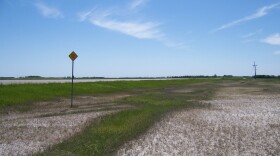CBS Sunday Morning aired a story a couple weeks ago on people searching out larch trees in the western mountains during the fall to observe their golden colored needles.
Not native to North Dakota
Although there are no larch native to North Dakota, an introduced species is grown as an ornamental in the state. A larch or tamarack is native in states and provinces nearby, though — including Minnesota, Montana, Manitoba, and Saskatchewan.
Members of the genus Larix, commonly known as larch or tamarack, are rather unique in that they are deciduous conifers. Most people think of conifers as evergreens, but there are a few exceptions, and this group is one of them.
The needles of these species are produced in dense clusters of 20-50 needles, 1/2” to 2” long on short shoots. They turn a golden-yellow during the fall before dropping. As you might expect, during the winter months they look like dead evergreens trees.
Tamarack and Black Spruce
American larch or tamarack (Larix laricina) is a common species in the north woods of Minnesota and much of Canada, particularly in wet and boggy areas. If you see a conifer growing on a bog in northern Minnesota, the odds are it is either tamarack or black spruce.
Sigurd Olson, renowned naturalist, author, and person instrumental in getting the Boundary Waters Canoe Area Wilderness established wrote about the fall color of tamarack in his book The Singing Wilderness (1977):
“The leaves are gone from the hillsides and the glory of the red maple and of the yellow aspen and birch is strewn upon the ground. Only in the protected swamps is there any color, the smoky gold of the tamaracks…These are days of quietly falling needles where after each breath of wind the air is smoky with their drift.”
Siberian larch in North Dakota
If you have observed a conifer that sheds its needles each fall in North Dakota, it is probably Siberian larch (Larix sibirica) — an introduced ornamental. I have seen larch along the blacktop just north of Towner, on North Dakota Forest Service land in Turtle Mountain, and at the Denbigh Experimental Forest. No doubt larch are in other places as well.
The trees are not dying!
Some people that are unaware that larch is a deciduous conifer may assume that the tree is dying when in the fall the needles all turn yellow and drop. As a result, healthy tamarack trees are occasionally cut down. Please keep that in mind if you see all the needles turning yellow and dropping on a seemingly healthy evergreen in the fall.





